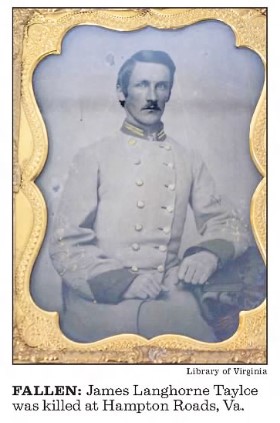JAMES L. TAYLOE, LT, CSN
James Tayloe '60
James Langhorne Tayloe was admitted to the Naval Academy from Virginia on September 24, 1855 at age 14 years 11 months.
Photographs
Loss
From Find A Grave:
James Langhorne Tayloe, born Roanoke, Virginia, [October 5, 1840]; son of William Tayloe; attended Episcopal High School, Alexandria, Virginia; entered the United States Naval Academy; graduated 1860; resigned from the United States Navy, June 6, 1861, and entered the Confederate States Navy, July 8, 1861, as acting Midshipman; in command of the CSS Fanny at the battle of Roanoke; promoted Master, September 24, 1861, and Lieutenant, February 10, 1862; killed in action aboard the CSS Raleigh, March 8, 1862, at Hampton Roads, Virginia.
James was stationed on CSS Raleigh (1861), but was aboard CSS Beaufort when he was killed during the Battle of Hampton Roads. He is buried in Virginia.
Other Information
From records of the US Naval Academy Graduates’ Association:
JAMES LANGHORNE TAYLOE, Graduate No. 395.
1855, September 24, appointed an Acting Midshipman on probation at the Naval Academy, from Virginia. 1860, June 15, graduated, and warranted as a Midshipman. July 24, ordered to the Susquehanna, Mediterranean Squadron, to report on the 15th of August. 1861, July 5, dismissed the service, having tendered his resignation.
Sea service, 1 year, 8 months; shore duty, 3 years, 11 months; unemployed, 2 months; in service, 5 years, 9 months.
Lieutenant James L. Tayloe was wounded in the naval action at Newport News, March 8, 1862, and died at the Naval Hospital, Norfolk, on the 11th. He was born in Roanoke County, Virginia, and had attained his twenty-first year. He was a graduate of the Naval Academy, at which institution he was entered in 1855. In July, 1861, he returned to the United States from abroad, and threw up his appointment in the old service to offer his professional abilities to his native State. Habitually we speak well of the dead. The beautiful maxim of the ancients is easily violated; but, in his case, no ill could be spoken of him. There is no need of empty eulogy or formal praise. The actions by which his brief career were embellished are his most eloquent biographers. In August he was promoted for energy and good conduct at Oregon Inlet, and appointed Master Commanding to the prize steamer Fanny.
At the naval battle of Roanoke he was conspicuous for skill and courage. At Elizabeth City he fought his vessel to the last and then left her in flames, escaping as by miracle from the perils by which he was surrounded. For these distinguished exhibitions of valor and good conduct he was again promoted to the grade he held at the time of his untimely death. Two brevets within six months constitute in themselves most eloquent attestations of his skill and gallantry as an officer. It was in the last chapter of his short, brave life that these qualities were conspicuously displayed. He left the capital, which naturally had claims for a young and distinguished man, and hurried down to join his companions in arms on board the Raleigh, as a volunteer in the perils and glories of the expedition in which he fell.
On that memorable day the writer of this just tribute saw him on board that vessel, radiant with life. Full of noble aspirations and animated by a lofty patriotism he went down to meet the enemy. Sustained by that knightly courage which told him the post of honor was the post of danger, he bore himself gallantly through the fight, until at half-past four on the afternoon of that glorious day he fell, alongside the Congress, shot through the body by a fire of musketry at short range from the shore.
The melancholy fate of this gallant man is shrouded in a still deeper gloom by the fact that he fell in attempting a duty of humanity—that he fell in a mission of mercy, for his duty was to remove the Federal wounded, over whom the white flag was flying.
From the moment he was thus cruelly shot down he bore his sufferings with a fortitude which showed his mind and temper equal to any fate. He discharged his last earthly duties with heroic composure, and so, at seven o’clock on Tuesday morning, his soul went up to, the God who gave it and his name passed into the pages of history.
His personal character was above all praise. Of a generosity which knew no negative; of an amiability which had no feuds; of a candor which had no concealments, and a warmth of temper which made him a friend to all with whom he was associated, he was loved by all who knew him—praised by all who spoke his name.
His person was as prepossessing as his character. Of a hopeful and resolute aspect, he united the frankness of the seaman with the courtliness of a Virginia gentleman. The graceful proportions of his body corresponded well with his happy temper and gracious mind; in short, the kindly elements all blent in him to “Give the world assurance of a man.”
Henceforward when men speak of the heroes of this war, the name of Tayloe will be tenderly spoken. When the historians look for grand heroic figures to embellish their work the graceful figure of this gallant young seaman will live again, and his fame on earth will be as enduring as man’s admiration for chivalry of character and nobility of soul. And now that it hath pleased the Almighty to take out of this world the soul of our departed brother, let these so sorely smitten remember that he fell with his front to the enemy ; that while his mortal remains rest on the “ deathbed of fame,” his spirit has ascended to the God who gave it, and that their sorrow is felt and shared by all who knew him. “ The Lord hath given, and the Lord hath taken away; blessed be the name of the Lord.” James B. Hope
Note this is the only report found of him being killed while under a white flag of truce. It is also unlikely Congress was within small-arms range of the shore; the area was, however, under artillery fire.
From researcher Kathy Franz:
James was raised in Big Lick, Virginia. His father George Plater Tayloe married Mary Elizabeth (Langhorne) in 1830. The Tayloes and the nearby Langhornes were slaveholders. Mary died in 1848 giving birth to daughter Virginia.
Per The Roanoke Times, May 5, 1914: George was elected to represent Roanoke county at the constitutional convention in Virginia. He sent his four sons to defend Virginia; one was George E. Tayloe, colonel of the Eleventh Alabama regiment, wounded at the Crater and acting as brigadier-general at Appomattox. Another was Lt. James L. Tayloe of the Raleigh killed in the naval engagement preceding the battle between the Merrimac and Monitor. The other two were Major (John) W. Tayloe, second adjutant Virginia cavalry, and Lomax Tayloe, adjutant of the same regiment, killed at Raccoon Ford.
James wrote to his father from aboard the CSS Fanny at Roanoke Island three months before he died. He suggested a wharf on the Portsmouth side of the river in Norfolk could be bought low now and would be a valuable investment after the war.
James' other siblings were: Eliza (Mrs. Thomas T. Munford,) Ann (Mrs. John D. Langhorne,) Mary (Mrs. William M. Gwathmey,) Rosa (Mrs. E. Thornton Tayloe,) and Virginia (Mrs. Mortimer M. Rogers.)
James' grandfather Col. John Tayloe, III, built the Octagon House in Washington, D. C.
James' uncle Benjamin Ogle Tayloe lived across from the White House, and his dinners included many famous people, such as James Buchanan, Daniel Webster, John C. Calhoun, and Henry Clay. Benjamin's son E. Thornton married James' sister Rosa.
James' namesake Dr. James Tayloe Gwathmey was the son of James' sister Mary. He discovered a new anaesthetic in 1904.
He is listed on the killed in action panel in the front of Memorial Hall.
Career
From the Naval History and Heritage Command:
Acting Midshipman, 24 September, 1855. Midshipman, 15 June, 1860. Dismissed 5 July, 1861.
Related Articles
William Hutter '63 was also killed in this engagement.
Memorial Hall Error
His last name was spelled "Tayloe." Memorial Hall has "Taylor."
Confederates in Memorial Hall
This alumni is included on this site because he is listed in Memorial Hall. Pursuant to Section 377 of the National Defense Authorization Act for Fiscal Year 2021, the Naming Commission found, per Part II of their final report to Congress, that "Due to the limited factual nature of [Memorial Hall], the Commission believes it may remain as structured."
The "Register of Commissioned and Warrant Officers of the United States Navy and Marine Corps" was published annually from 1815 through at least the 1970s; it provided rank, command or station, and occasionally billet until the beginning of World War II when command/station was no longer included. Scanned copies were reviewed and data entered from the mid-1840s through 1922, when more-frequent Navy Directories were available.
The Navy Directory was a publication that provided information on the command, billet, and rank of every active and retired naval officer. Single editions have been found online from January 1915 and March 1918, and then from three to six editions per year from 1923 through 1940; the final edition is from April 1941.
The entries in both series of documents are sometimes cryptic and confusing. They are often inconsistent, even within an edition, with the name of commands; this is especially true for aviation squadrons in the 1920s and early 1930s.
Alumni listed at the same command may or may not have had significant interactions; they could have shared a stateroom or workspace, stood many hours of watch together… or, especially at the larger commands, they might not have known each other at all. The information provides the opportunity to draw connections that are otherwise invisible, though, and gives a fuller view of the professional experiences of these alumni in Memorial Hall.
January 1860
September 1861
James is the only member of the Class of 1860 in Memorial Hall.

The "category" links below lead to lists of related Honorees; use them to explore further the service and sacrifice of alumni in Memorial Hall.

